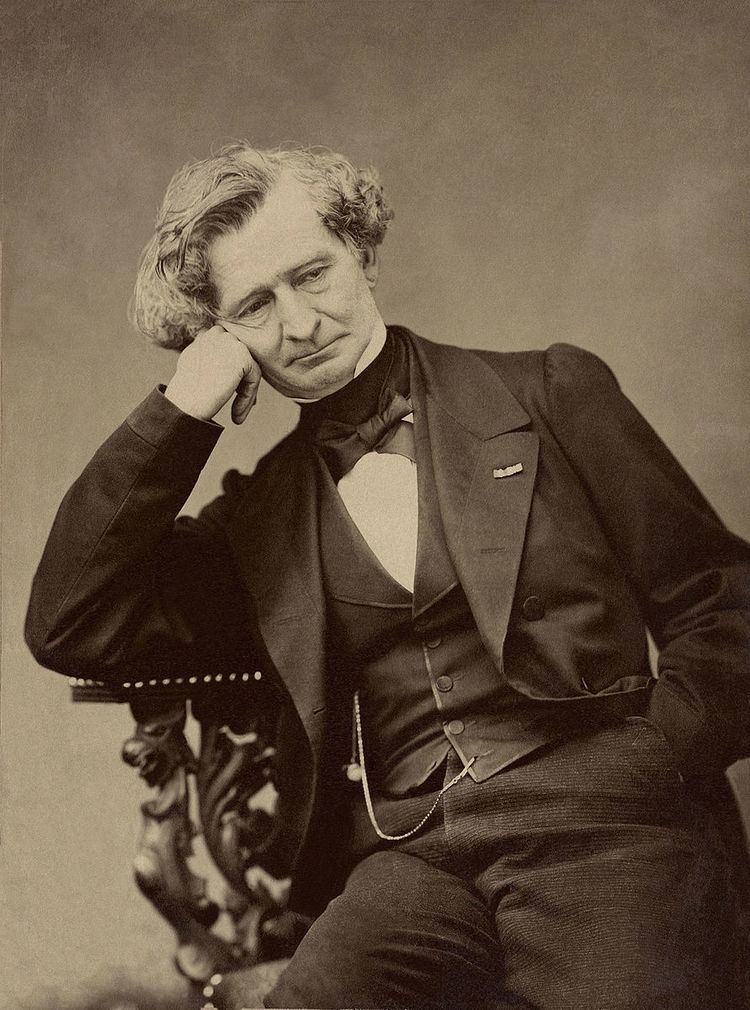 | ||
Harold en Italie, Symphonie en quatre parties avec un alto principal (English: Harold in Italy, Symphony in Four Parts with Viola Obbligato), Op. 16, is Hector Berlioz's second symphony, written in 1834.
Contents
Creation
Niccolò Paganini (1782–1840) encouraged Berlioz (1803–1869) to write Harold en Italie. The two first met after a concert of Berlioz’s works conducted by Narcisse Girard on 22 December 1833, three years after the premiere of Berlioz’s Symphonie fantastique. Paganini had acquired a superb viola, a Stradivarius—"But I have no suitable music. Would you like to write a solo for viola? You are the only one I can trust for this task."
Berlioz began "by writing a solo for viola, but one which involved the orchestra in such a way as not to reduce the effectiveness of the orchestral contribution." When Paganini saw the sketch of the allegro movement, with all the rests in the viola part, he told Berlioz it would not do, and that he expected to be playing continuously. They then parted, with Paganini disappointed.
Description
Harold en Italie is a four-movement work featuring an extensive part for solo viola.
Lord Byron's poem Childe Harold's Pilgrimage inspired the mood of Harold. Berlioz wrote, "My intention was to write a series of orchestral scenes, in which the solo viola would be involved as a more or less active participant while retaining its own character. By placing it among the poetic memories formed from my wanderings in the Abruzzi, I wanted to make the viola a kind of melancholy dreamer in the manner of Byron’s Childe-Harold." That he had recycled some of the material from his discarded concert overture, Rob Roy, went unmentioned. Despite Berlioz' mention of Byron, music critics, such as Donald Tovey have taken pains to point out that "Harold in Italy" owes nearly nothing to the poem: "no definite elements of Byron's poem have penetrated the impregnable fortress of Berlioz's encyclopaedic inattention,...there is no trace in Berlioz's music of any of the famous passages of Childe Harold."
The first movement ("Harold aux montagnes") refers to the scenes that Harold, the melancholic character, encounters in mountains. In the second movement ("Marche des pèlerins"), Harold accompanies a group of pilgrims.
The third movement ("Sérénade") involves a love scene; someone plays a serenade for his mistress. In the fourth movement, ("Orgie de brigands"), spiritually tired and depressed, Harold seeks comfort among wild and dangerous company, perhaps in a tavern. Jacques Barzun reminds us that "The brigand of Berlioz’s time is the avenger of social injustice, the rebel against the City, who resorts to nature for healing the wounds of social man."
Throughout the symphony, the viola represents Harold's character. The manner in which the viola theme hesitantly repeats its opening phrase—gaining confidence, like an idea forming, before the long melody spills out in its entirety—was satirized in a musical paper after the premiere. It began "Ha! ha! ha! – haro! haro! Harold!"—a cheeky touch that Berlioz recalled years later in his Memoirs.
In addition to the solo viola, the work calls for 2 flutes (2nd doubling piccolo), 2 oboes (1st doubling cor anglais in Movement III), 2 clarinets in C (Movements I, III, and IV) and A (Movement II), 4 bassoons, 4 horns, 2 cornets, 2 trumpets, 3 trombones, tuba, timpani, cymbals, triangle, 2 tambourines, harp and strings.
History
Harold in Italy was premiered on 23 November 1834 with the Orchestre de la Société des Concerts du Conservatoire, Chrétien Urhan playing the viola part, Narcisse Girard conducting. Even though the second movement "March of the Pilgrims" received an encore, this performance contributed to Berlioz's decision to conduct his own music in the future.
Paganini did not hear the work he had commissioned until 16 December 1838; then he was so overwhelmed by it that, following the performance, he dragged Berlioz onto the stage and there knelt and kissed his hand before a wildly cheering audience and applauding musicians. A few days later he sent Berlioz a letter of congratulations, enclosing a bank draft for 20,000 francs.
Franz Liszt prepared a piano transcription (with viola accompaniment) of the work in 1836 (S.472).
The first studio recording was made by RCA in 1944 with William Primrose and the Boston Symphony Orchestra conducted by Serge Koussevitzky.
The piece was used in Terrence Malick's 2013 film To The Wonder, starring Ben Affleck and Olga Kurylenko. The film has several visual references to the composition's content and history.
